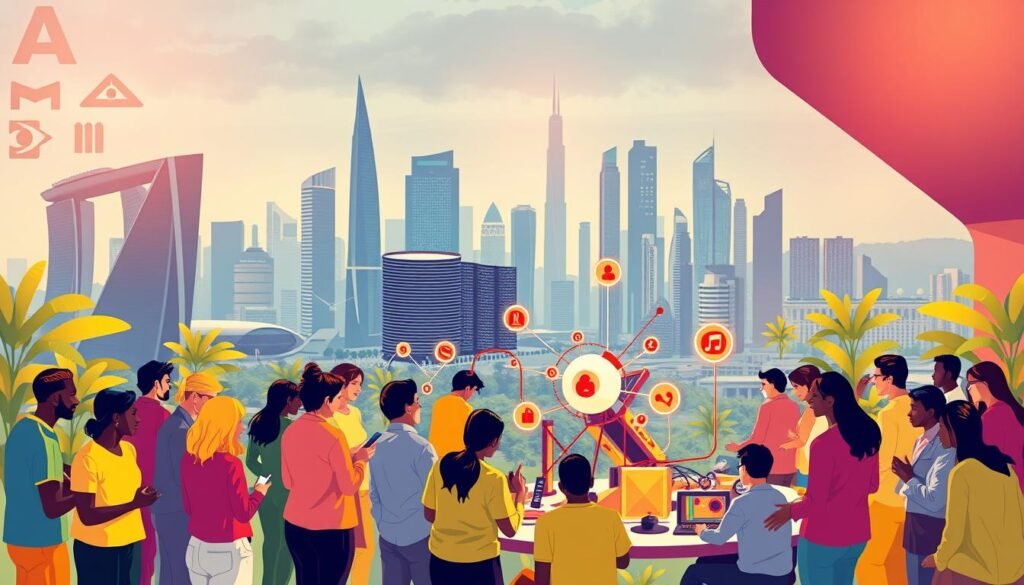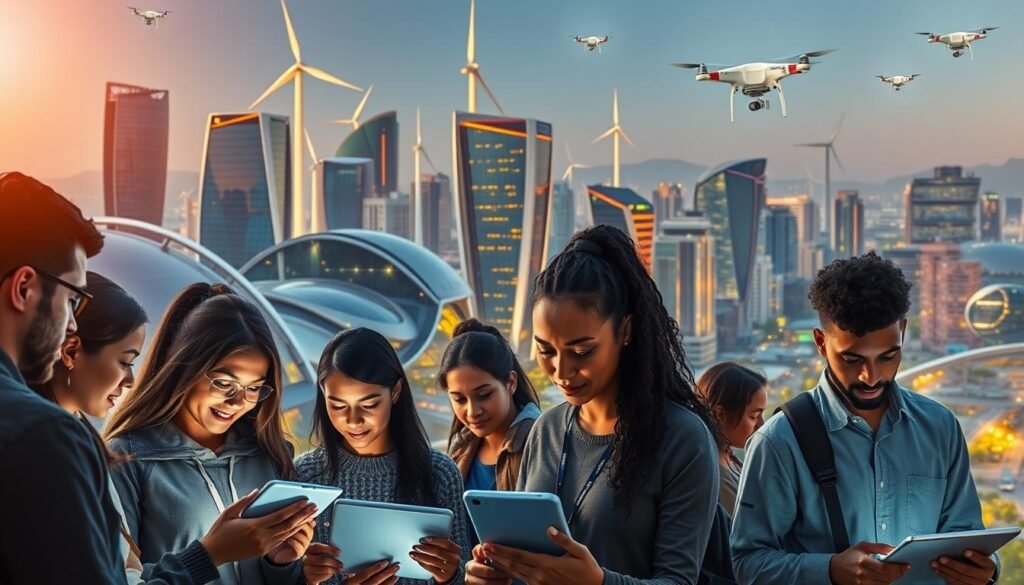Table of Contents
Have you ever wondered how we can tackle some of the world’s most pressing challenges? From poverty to climate change, the answers often lie in social innovation. But what exactly does this term mean, and why is it so important today?
At its core, social innovation refers to the process of developing effective solutions to systemic social and environmental issues. It’s not just about ideas; it’s about creating real, lasting change. This approach often involves collaboration across sectors, bringing together governments, businesses, and nonprofits to achieve a common goal.
Examples of social innovation are all around us. Think of microfinance, which provides financial services to underserved communities, or renewable energy projects that reduce our carbon footprint. These initiatives show how creative thinking can drive social impact and improve lives.
This guide will walk you through the basics of social innovation, its characteristics, and real-world applications. Whether you’re new to the concept or looking to deepen your understanding, you’ll find valuable insights here.
Key Takeaways
- Social innovation addresses systemic social and environmental issues.
- It requires collaboration across governments, businesses, and nonprofits.
- Examples include microfinance and renewable energy projects.
- It focuses on creating lasting change and improving lives.
- This guide covers definitions, characteristics, and real-world applications.
Introduction to Social Innovation
The journey of solving global issues through collaborative efforts began gaining momentum in the early 2000s. In 2003, the Stanford Social Innovation Review launched, focusing on cross-sector dialogue. This initiative aimed to bridge the gap between public, private, and nonprofit sectors, creating a foundation for social innovation.
After the 2008 financial crisis, there was a significant surge in social entrepreneurship models. Businesses started integrating corporate social responsibility into their strategies. This shift highlighted the importance of addressing systemic challenges through innovative solutions.
Today, the UN Sustainable Development Goals serve as a modern framework for these efforts. They provide a roadmap for tackling pressing issues like poverty, inequality, and climate change. This global focus has led to a 68% increase in social innovation startups since 2015.
In the post-pandemic world, these initiatives are more critical than ever. They offer opportunities to rebuild economies while addressing long-standing societal challenges. By leveraging cross-sector collaboration, we can create lasting change and improve lives across the world.
Defining Social Innovation
Understanding the essence of solving societal challenges requires a clear definition. According to IdeaScale, it involves “strategically developing inventive ideas to address societal challenges through collaborative solutions.” This approach focuses on creating value for communities while tackling systemic problems.

What Does Social Innovation Mean?
At its core, social innovation is about finding solutions that benefit society as a whole. Unlike traditional methods, it emphasizes long-term impact over short-term gains. For example, Grameen Bank’s microfinance model boasts a 97% repayment rate, showcasing how sustainable models can address financial exclusion.
How Social Innovation Differs from Traditional Innovation
Traditional innovation often prioritizes financial returns, while social innovation measures success through social ROI. Take FLO’s fair trade certification as an example. It’s not just about product quality but ensuring fair wages and ethical practices for farmers.
Another key difference lies in the “triple bottom line” concept, which balances people, planet, and profit. This approach ensures that solutions are not only effective but also ethical and sustainable. Unlike corporate social responsibility (CSR), which focuses on philanthropy, social innovation targets root causes to create lasting change.
The Importance of Social Innovation
Why does addressing societal challenges require a fresh approach? Traditional methods often fall short in meeting the needs of communities. Social innovation steps in to fill these gaps, creating solutions that have a lasting impact.
One key area is financial inclusion. By 2020, microfinance programs reached 140 million low-income borrowers globally. This shows how innovative approaches can address market failures and empower underserved communities.
Another critical role is enabling the UN Sustainable Development Goals (SDGs). Achieving these goals requires $5-7 trillion in annual investments. Social innovation helps mobilize resources and design effective programs to meet these ambitious targets.
Climate change is another pressing issue. Renewable energy projects offset 2.1 billion tons of CO2 in 2022. These initiatives demonstrate how innovative solutions can prevent environmental catastrophe while driving economic growth.
In the US, social enterprises contribute $500 billion to the GDP. This highlights the economic impact of purpose-driven initiatives. Additionally, 76% of Gen Z prioritizes working for organizations that align with their values, showing a shift toward civic engagement.
By addressing systemic challenges, social innovation creates a better future for society. It ensures that needs are met, resources are used wisely, and programs deliver real results. This approach is essential for building a sustainable and equitable world.
Key Characteristics of Social Innovation
What makes effective solutions to societal challenges stand out? It’s the unique combination of social impact, collaboration, and systems thinking. These traits ensure that initiatives not only address immediate needs but also create lasting change.

Social Impact
At the heart of every successful initiative is measurable social impact. For example, Fairtrade certified producers have seen a 30% increase in income, showcasing how ethical practices can transform lives. Tools like IRIS+ metrics help track social ROI, ensuring that programs deliver real results.
Barcelona’s superblocks project is another example. By redesigning urban spaces, the city reduced air pollution by 25%, improving public health and quality of life. These outcomes highlight the importance of focusing on tangible benefits for communities.
Collaboration and Co-Creation
Effective solutions often emerge from collaboration. MIT’s Climate CoLab engaged 80,000 participants in developing climate solutions, proving that diverse perspectives lead to better outcomes. Similarly, Ushahidi’s crisis mapping platform was built through global open-source teamwork, demonstrating the power of co-creation.
Circular economy models in Scandinavian countries achieve 92% material reuse, thanks to partnerships between businesses, governments, and communities. These examples show how working together can drive innovation and sustainability.
Systems Thinking
Addressing complex challenges requires systems thinking. This approach considers the interconnectedness of social, economic, and environmental factors. For instance, renewable energy projects not only reduce emissions but also create jobs and boost local economies.
By focusing on the bigger picture, systems thinking ensures that solutions are holistic and sustainable. It’s a key trait that sets successful initiatives apart, enabling them to tackle root causes rather than symptoms.
Real-World Examples of Social Innovation
Across the globe, impactful initiatives are transforming lives and communities. These examples show how creative solutions can address systemic challenges and create lasting change. From financial inclusion to clean energy, innovative projects are making a difference.
Microfinance
Microfinance has revolutionized access to financial services for underserved communities. Grameen Bank, for instance, has provided $28 billion in loans to 9.4 million borrowers, 97% of whom are women. This model empowers individuals to start businesses and improve their livelihoods.
Kenya’s M-Pesa is another success story, enabling $56 billion in mobile money transactions. This system has brought financial inclusion to millions, proving that innovative solutions can bridge gaps in traditional banking.
Renewable Energy Initiatives
Renewable energy projects are addressing climate change while improving access to power. M-Kopa Solar’s pay-as-you-go systems have powered 1 million African homes, providing clean and affordable energy.
Tesla’s Virtual Power Plant in South Australia connects 50,000 homes to trade solar energy. This initiative not only reduces emissions but also creates a sustainable energy network.
Social Entrepreneurship
Social entrepreneurship combines business acumen with a focus on societal impact. TOMS Shoes, for example, invests one-third of its profits in grassroots organizations, supporting local communities.
Patagonia’s Worn Wear program has repaired over 100,000 garments, keeping waste out of landfills. These examples highlight how businesses can drive positive change while remaining profitable.
Mechanisms of Social Innovation
How do effective solutions to societal challenges come to life? The answer lies in understanding the process and strategies that drive impactful initiatives. From ideation to institutionalization, these mechanisms ensure that solutions are scalable and sustainable.

The four-stage lifecycle is a cornerstone of this process. It begins with ideation, where creative solutions are brainstormed. Development follows, turning ideas into actionable plans. Scaling ensures these plans reach a wider audience, while institutionalization embeds them into systems for long-term impact.
Policy mechanisms also play a crucial role. For example, the EU’s Social Innovation Competition has funded over 750 projects, fostering collaboration across sectors. These initiatives often involve government support, ensuring that solutions align with public needs.
Corporate partnerships are another key driver. Google.org’s $200M AI for Social Good initiative demonstrates how businesses can contribute to societal progress. By leveraging technology, these partnerships address challenges like healthcare and education, benefiting people worldwide.
Digital infrastructure, such as India’s Aadhaar biometric system, serves as a foundation for innovation. With 1.3 billion users, it showcases how technology can empower people and streamline services. Similarly, crowdlaw platforms in 28 countries enable citizens to participate in legislation drafting, fostering transparency and inclusivity.
These mechanisms highlight the importance of collaboration across sectors and the role of government in driving change. By understanding these processes, we can create solutions that truly make a difference.
Best Practices for Social Innovation
Creating meaningful change requires more than just good intentions; it demands strategic approaches and proven methods. By following best practices, organizations can design effective programs that address societal challenges and deliver measurable results.
Understanding the Problem
Before developing solutions, it’s crucial to fully understand the problem. Tools like the Living Wage Calculator, used by 1,200+ U.S. companies, help ensure equitable pay structures. This approach ensures that resources are allocated effectively to meet community needs.
Human-centered design, such as IDEO.org’s methods, has a 73% success rate in solution adoption. By focusing on the people affected, organizations can create solutions that are both practical and impactful.
Embracing Collaboration
Effective solutions often emerge from collaboration across sectors. C40 Cities, a climate action network, spans 100 municipalities worldwide. Such cross-sector coalitions pool resources and expertise to tackle complex challenges.
B Corp certification, achieved by 6,500 companies, ensures businesses meet verified social and environmental standards. This certification fosters trust and accountability, encouraging more organizations to join the movement.
Iterative Learning
Iterative learning allows organizations to refine their approaches over time. Proximity Designs, for example, tested 182 farm tool prototypes before launching their final product. This process ensures that solutions are both effective and scalable.
Impact sourcing, like Digital Divide Data’s model, employs an 85% marginalized workforce. By continuously improving their programs, organizations can maximize their social impact while addressing systemic issues.
By adopting these best practices, organizations can create sustainable solutions that truly make a difference. Collaboration, understanding, and iterative learning are key to driving meaningful change.
The Role of Technology in Social Innovation
Technology is reshaping how we address global challenges, offering new tools and approaches. From drones delivering medical supplies to AI predicting disease outbreaks, digital innovation is driving impactful solutions.

Zipline’s drones have delivered over 1 million medical units in Rwanda and Ghana. This technology ensures life-saving supplies reach remote areas quickly, showcasing how innovation can bridge gaps in healthcare services.
Blockchain is another game-changer. IBM Food Trust is used by 64% of food banks to ensure supply chain transparency. This digital innovation builds trust and reduces waste, benefiting both producers and consumers.
AI applications are also making a difference. PATH’s malaria prediction models achieve 89% accuracy, helping communities prepare for outbreaks. These solutions demonstrate how technology can enhance public health efforts.
3D printing is transforming accessibility. Not Impossible Labs produces $100 prosthetic arms for war victims, providing affordable support to those in need. This innovation shows how creativity can address complex challenges.
Satellite monitoring, like Global Forest Watch, detects illegal logging in real-time. This technology helps protect ecosystems and promotes sustainable practices.
VR training is improving caregiving. Embodied Labs’ simulations have reduced elder abuse by 40%, highlighting how digital innovation can enhance skills and empathy.
These examples illustrate the transformative power of technology in creating meaningful solutions. By leveraging these tools, we can tackle global challenges more effectively and efficiently.
Challenges in Social Innovation
What obstacles stand in the way of creating meaningful change? Despite the potential of impactful initiatives, many face significant challenges that hinder their growth and effectiveness. From funding gaps to policy barriers, these issues require careful attention and innovative solutions.
One major hurdle is the lack of financial resources. The UNCTAD reports a $2.5 trillion annual deficit in financing for the Sustainable Development Goals (SDGs). This funding gap limits the ability of organizations to scale their efforts and achieve long-term sustainability.
Another challenge is the complexity of measuring impact. According to a study, 44% of impact investors lack standardized metrics. Without clear measurement tools, it’s difficult to assess the effectiveness of programs and allocate resources efficiently.
Policy barriers also pose significant obstacles. In 78 countries, foreign NGO operations face restrictions, limiting their ability to address local needs. These regulations can stifle collaboration and innovation, making it harder to implement effective solutions.
The technological divide further complicates matters. The ITU estimates that 3.7 billion people remain offline, cutting them off from digital tools and resources. Bridging this gap is essential for ensuring equitable access to innovative solutions.
Finally, the scalability paradox presents a unique challenge. While models like Kiva’s microfinance platform have achieved global success, context-specific needs often require tailored approaches. Balancing scalability with local relevance is crucial for long-term impact.
Addressing these challenges requires a combination of strategic design, cross-sector collaboration, and innovative thinking. By overcoming these barriers, organizations can create solutions that drive meaningful change and promote sustainability.
Conclusion
Creating lasting change requires more than ideas; it demands action and collaboration. By integrating collaborative models, leveraging technology, and addressing systemic issues, we can drive meaningful progress in society.
To get involved, start by identifying local challenges, partnering with like-minded organizations, and advocating for supportive policies. The future looks promising, with the social innovation market projected to reach $3 trillion by 2030.
For further exploration, platforms like the Stanford Social Innovation Review, Ashoka, and the Skoll Foundation offer valuable resources. As Sarah Soule aptly said, “Innovation without impact is just invention.” Let’s work together to seize these opportunities and create a better world.
FAQ
What does social innovation mean?
It refers to new strategies, concepts, or solutions that address societal challenges effectively. These efforts aim to improve communities and create lasting positive change.
How does social innovation differ from traditional innovation?
Traditional innovation often focuses on profit or market growth, while this approach prioritizes solving pressing issues like poverty, education, or environmental sustainability.
Why is social innovation important?
It drives progress by tackling complex problems that governments or businesses alone cannot solve. It empowers communities and fosters sustainable development.
What are the key characteristics of social innovation?
Key traits include measurable impact, collaboration among diverse stakeholders, and a focus on systemic change rather than temporary fixes.
Can you provide examples of social innovation?
Examples include microfinance programs, renewable energy projects, and ventures that combine business models with community benefits.
What are the best practices for social innovation?
Understanding the root cause of problems, fostering partnerships, and adopting an iterative approach to learning and improvement are essential.
How does technology play a role in social innovation?
Technology enables scalable solutions, from mobile apps for education to platforms that connect resources with underserved populations.
What challenges are faced in social innovation?
Common obstacles include securing funding, measuring impact, and navigating complex systems to implement sustainable solutions.


